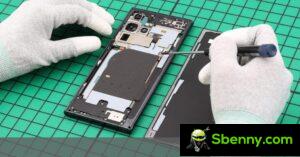Traditionally, Apple sells more Pro models than vanilla ones. Both definitely have their place in the market and, in our experience, typically tend to appeal to different audiences.
However, you may be wondering whether to buy the regular iPhone 15 or the iPhone 15 Pro. Apple continues to introduce a lot of segmentation between its Vanilla and Pro models, but this undoubtedly varies from year to year.
With its new display, the inclusion of Dynamic Island, and the move to a new 48MP camera, the vanilla model is probably closer to the Pro this year, more so than in recent years. However, it’s worth examining the differences and similarities in detail to try and justify some savings or extra spending on a brand new iPhone.
Size comparison
The vanilla iPhone 15 and the Pro are very similar in terms of physical proportions. The ordinary 15 is slightly taller and wider, while the Pro makes up for the difference with a thicker profile. However, the two phones are remarkably similar in practice and in person, feeling almost identical to the touch.
The iPhone 15 Pro is noticeably heavier 187 gramsas compared to 171 grams on vanilla. Once again, however, in practice the difference is not that substantial.
This year, Apple managed to reduce the weight of the Pro models a bit, making them the lightest Pro models ever, by opting for a titanium chassis instead of stainless steel, as in the past.
The standard iPhone 15 instead has an aluminum frame, which may be more malleable and easier to dent and scratch, but it’s still an excellent material worthy of a modern premium phone.

Both iPhones have a new bevel around the center frame that softens the edges and provides a more comfortable feel when holding it.
While we’re pointing out the differences, while both iPhone models have the same size displays with flat panels, the actual shape of the top glass isn’t identical. On the iPhone 15 Pro, the glass extends above the center frame and then slopes downwards, arguably creating a more modern and premium look. On the standard iPhone 15, the glass fits into the central frame. It’s a subtle difference in design, but one of the few that can be especially appreciated in person.
Technically, the iPhone 15 Pro has the best in the screen-to-body ratio department with a 88.2% figure, compared to 86.4%thanks to thinner display bezels.
Distinguishing the two phones is a little more difficult this year since Dynamic Island has finally made its way to the vanilla iPhone. The difference is immediately noticeable from the back due to the different number of cameras.
The body colors are a dead giveaway, and while the Pro’s new titanium finishes look very attractive in their own right, our personal preference here is for the vibrant, colorful finishes of the Vanilla iPhone 15, which you can see you get the brand new black, blue, green, yellow and pink shades.
In terms of other materials and protection, aside from the difference in chassis we’ve already noted, both phones have some type of Corning-Mage glass on the back and Ceramic Shield glass on the front. Both phones also have an IP68 rating, allowing them to survive up to 30 minutes in up to 6 meters of fresh water.
View the comparison
Both the iPhone 15 and iPhone 15 Pro are compact 6.1 inches display, one of OLED XDR Super Retina variety. Both phones also advertise amazing and identical brightness values 1,000 nits in normal mode and up to 2,000 nits peak. iPhones remain a little more conservative in increasing and maintaining boosted brightness in sunlight than most modern Android competitors, but even so, the difference in brightness is noticeable in practice and much appreciated.
Both the iPhone 15 and iPhone 15 Pro also have the exact same display resolution 1179 x 2556 pixels – perfectly sharp in practice.
The only major difference in display technology between the standard iPhone 15 and the Pro is the inclusion of variable, high refresh rates on the Pro. Apple calls this feature ProMotion, and as the name suggests, it continues to be relegated to models Pro. It’s a real shame that Cupertino didn’t decide to at least bring the standard iPhone 15 display up to 90Hz, given that high refresh rate is so prolific and easily obtainable in the Android realm these days and that too with a lot less money.
The LTPO display on the iPhone 15 Pro can refresh up to 120Hz and go as low as 1Hz, which is what Apple leverages for its always-on display feature.
The Always-On Display is also annoyingly missing from the vanilla iPhone 15, and not due to any obvious technical limitations, but presumably as a consequence of the lack of variable refresh rate and Apple’s desire not to damage the battery life figures on the model vanilla.
Battery life
Given that the iPhone 15 and 15 Pro have similarly sized bodies, it’s no surprise that they house battery packs of very similar capacity. However, with less hardware to fit, the Vanilla manages to fill a slightly larger one 3349 mAh battery, compared to 3274 mAh in the Pro. Not really a substantial difference.
In practice, however, after putting both phones through their paces, we can confidently say that the regular iPhone 15 offers noticeably, if not surprisingly, better battery life. It turned out a solid 98 hours of resistance in our tests, compared to 86 hours on the iPhone 15 Pro. Both phones performed quite similarly in terms of standby and call performance, with most of the difference coming from higher screen test times on the iPhone 15. This is likely achieved through a combination of chipset and display power efficiency, but regardless, the iPhone 15 scores a small victory in this department.
Charging speed
Apple has always been a bit ambiguous when it comes to charging iPhones. According to the official specifications, both the iPhone 15 and iPhone 15 Pro should be able to charge from zero to 50% in 30 minutes. And indeed, both phones handle and surpass this task easily.
Apple isn’t clear on which charger you should buy for your iPhone since none are included in the box. The advertised charging speed is achieved “with a 20W or higher adapter”, our tests verify that both the iPhone 15 and iPhone 15 Pro tend to charge at a maximum of around 20-21W.
In our tests, the iPhone 15 and 15 Pro have very similar charging curves, at least up to the last percentage of battery capacity. Both phones managed to go from zero to 32% in 15 minutes and then around 58% in half an hour, exceeding Apple’s marketing promises. An hour on the charger made us dizzy 86% for free on both phones.
After the first hour or so, however, charging on the standard iPhone 15 drops quite aggressively to only about 4W for some reason. This results in a total charging time of 1:50 on the vanilla iPhone 15, compared to 1:33 on the iPhone 15 Pro.
We can only speculate as to why this difference is there, but it’s consistent, which technically means we have to give a small edge to the iPhone 15 Pro, even though in practical terms both phones charge at a fairly similar speed.
Test the speakers
The usual hybrid stereo speaker is used on the iPhone 15 and 15 Pro: the earpiece acts as a second channel, joining the dedicated bottom speaker to provide a stereo experience. Apple also does a bit of intelligent crosstalk cancellation on its speakers by having each speaker output some of the “opposite” channels but at a lower volume.
Overall, we are once again seeing a very similar setup on both phones in terms of hardware and performance. In typical iPhone fashion, the audio output here is excellent. Volume gets a “GOOD” rating on both phones in our tests and is just a little shy of a “VERY GOOD” rating. There’s a surprising amount of bass output, and both phones also have a very nice delivery of vocals and crisp treble.
You can’t go wrong with either phone in this department.
Performance
The iPhone 15 uses last year’s top-tier A16 Bionic chipset, while the iPhone 15 Pro is powered by Apple’s latest invention: the Apple A17 Pro chipset. The Bionic moniker no longer exists, as this new piece of silicon takes iPhone models to a whole new level with console-level graphics and ray tracing hardware acceleration – Apple’s marketing talk, of course.
The new Apple A17 Pro chipset is the first mass-market SoC produced by TSMC on a 3nm process node. This, along with architectural advances, has resulted in what Apple calls the “most efficient mobile CPU” and one that offers 3x better performance per watt than the “competition” with its efficient cores. However, we’re not entirely sure what exactly this competition is.
Marketing talk is fine and all, but let’s backtrack a bit and look at some actual performance metrics, starting with the CPU. The A17 Pro should be around 10% faster than the A16 Bionic on its performance cores. This should translate to about 16% better single-core scores and about 13% better multi-core scores in something like GeekBench. It’s not a shocking difference, for sure.

Apple
iPhone15
AnTuTu 10
1,354,651
Geekbench 6
2,606 single cores
Geekbench 6
6,526 multicores

Apple
iPhone 15 Pro
AnTuTu 10
1,566,329
Geekbench 6
2,922 single-core
Geekbench 6
7,172 multicores
The A17 Pro gets a bigger boost in the GPU department. For starters, it has six GPU cores, one more than the five found in the A16 Bionic. These are apparently also new “professional class” graphics cores, with performance 20% faster than those of the A16 Bionic.
This year’s biggest innovation is hardware-accelerated ray tracing, which promises to be four times faster than software-based ray tracing on the A16 Bionic and should finally make “console-level” graphics on the iPhone a reality . It is not yet clear what this means in practical terms. However, Apple showed off some impressive capabilities during its launch event by promising that CAPCOM’s AAA games, such as Resident Evil 4 and Resident Evil Village, will come to iPhone as direct ports.
The iPhone 15 Pro also gets two extra gigs of RAM for a total of 8GB, compared to the standard iPhone 15’s 6GB. While this may not be a major difference at the moment, it could prove to be a limiting factor in the future. and a compelling reason why the standard iPhone 15 won’t receive some future iOS features.
Finally, we should mention that both the iPhone 15 and iPhone 15 Pro now have a USB Type-C port and both support USB Host/OTG via said port and Display Port video output. There are, however, differences in USB data connection speed dictated by different chipsets. The regular iPhone 15 is limited to USB 2.0 speeds of up to 480 Mbps. The iPhone 15 Pro, on the other hand, supports USB 3.2 Gen 2 data transfer speeds of up to 10 Gbps.
Camera comparison
As expected, there are some major differences in terms of camera between the standard iPhone 15 and the iPhone 15 Pro. Let’s start with the vanilla iPhone 15 first since it’s simpler. This year it will have a brand new 48MP main camera. Apple is working some computational and stacking magic to get 24MP still images, which are more detailed than any 12MP camera on previous iPhones thanks to a more feature-rich version of Apple’s Photonic Engine.
The standard iPhone 15 also features a 12MP ultrawide camera, which is somewhat similar to the Pro’s, but not quite, as it’s not as powerful and lacks autofocus, which the Pro leverages for macro photography . Also missing from the regular iPhone is the TOF 3D LiDAR scanner on the back of the phone for depth data.
At the front, both phones feature SL 3D depth sensing hardware for Face ID which also aids the selfie camera. The selfie on the iPhone 15 is actually quite similar to that of the Pro. Both have PDAF, but the iPhone 15 Pro also adds OIS.
The iPhone 15 Pro also has a 48MP main camera. It uses a significantly larger sensor than the Vanilla 15. You can now capture 48MP HEIF/JPG images alongside 48MP ProRAW. They’ve also come up with 28mm and 35mm equivalent digital zoom modes, and the iPhone will let you choose one of these focal lengths by default.
The ultrawide on the iPhone 15 Pro is carried forward from the previous generation. As mentioned, unlike that of the standard iPhone 15, it has autofocus, which allows it to also act as a macro.
The iPhone 15 Pro uses the same 3x unit as the 14 Pro, with the numbers appearing unchanged from the 13 Pro. However, you get a dedicated telephoto lens, which is another thing the standard iPhone 15 lacks.
Last but not least, it’s also worth noting that the regular iPhone 15 doesn’t have access to Apple’s proprietary ProRes video capture. 3D (spatial) video is only available on Pro models.
The iPhone 15 Pro generally offers a better overall camera setup and quality.



iPhone 15 camera examples: 0.5x • 1x • 2x
That said, the iPhone 15 certainly holds its own, and its new 48MP main camera is a big step up from the iPhone 14’s older 12MP camera.



iPhone 15 Pro camera examples: 0.5x • 1x • 3x
Both phones shine even in low light conditions. However, the iPhone 15 Pro has a slight edge overall, especially in the zoom department thanks to the use of the dedicated telephoto lens.


iPhone 15 Camera Examples: Low Light • Night Mode


iPhone 15 Pro camera examples: Low light • Night mode
Here’s a glimpse of how the iPhone 15’s main camera compares in image quality to that of the iPhone 15 Pro in our image comparison tool.
And here’s how the video quality of the iPhone 15’s main camera compares to that of the iPhone 15 Pro in our video comparison tool.
Verdict
At the time of writing, a base 6GB/128GB iPhone 15 has an MSRP of 799 USD/799 GBP/949 EUR/79,900 INR while a base 8GB/128GB iPhone 15 Pro should set you back USD 999/GBP 999/EUR 1,199/INR 134,900. So depending on where you live, the jump from Vanilla to Pro is definitely on a spectrum. Even so, Apple is clearly using the “bait effect”, commonly known as “popcorn pricing”, for its lineup as the standard iPhone 15 is more or less in terms of money, compared to the iPhone 15 Pro and all ‘iPhone 15 Pro. Max is not far from there.
While we can’t blame Apple at all for trying to sell to customers, the real question you, as a consumer, need to answer is whether the iPhone 15 Pro is worth the extra money.
Unless you really hate the new Pro Titanium color options, there’s no real reason to consider a vanilla iPhone over the Pro other than price. Unfortunately, there is no “right” answer and it will all depend on your personal desires and priorities.
Perhaps you’d appreciate the significantly better camera setup on the iPhone 15 Pro. Would you get a dedicated optical zoom camera, the ultrawide autofocus camera with macro capability, or the popular Apple ProRes video capture?
Not really a camera enthusiast? Maybe you like modern high refresh rate displays and simply can’t stand 60Hz anymore.
Or, perhaps, you find yourself drawn to the possibility of AAA, “console-level” gaming on the iPhone 15 Pro. The latter is more of a promise than a reality right now, but a good one nonetheless.
If any of the above appeals to you, it’s worth spending the extra money on an iPhone 15 Pro. Otherwise, the vanilla iPhone 15 will realistically get you most of the way, offer a similar overall experience, and hopefully last just as long. long.

- The lowest price.
- The lightest body.
- The most vibrant color options.
- Slightly better battery life.
Get the Apple iPhone 15 for:

- The ProMotion 120Hz adaptive refresh rate display.
- Charging speed a little faster.
- The most powerful chipset and future gaming potential.
- The USB port transfer speed is 10Gbps.
- The complete, premium camera system with telephoto and ultrawide autofocus for macro.







Start a new Thread